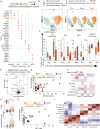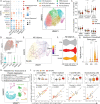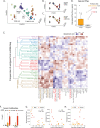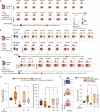This is a preprint.
Global Absence and Targeting of Protective Immune States in Severe COVID-19
- PMID: 33140041
- PMCID: PMC7605560
- DOI: 10.21203/rs.3.rs-97042/v1
Global Absence and Targeting of Protective Immune States in Severe COVID-19
Update in
-
Global absence and targeting of protective immune states in severe COVID-19.Nature. 2021 Mar;591(7848):124-130. doi: 10.1038/s41586-021-03234-7. Epub 2021 Jan 25. Nature. 2021. PMID: 33494096 Free PMC article.
Abstract
While SARS-CoV-2 infection has pleiotropic and systemic effects in some patients, many others experience milder symptoms. We sought a holistic understanding of the severe/mild distinction in COVID-19 pathology, and its origins. We performed a wholeblood preserving single-cell analysis protocol to integrate contributions from all major cell types including neutrophils, monocytes, platelets, lymphocytes and the contents of serum. Patients with mild COVID-19 disease display a coordinated pattern of interferonstimulated gene (ISG) expression across every cell population and these cells are systemically absent in patients with severe disease. Severe COVID-19 patients also paradoxically produce very high anti-SARS-CoV-2 antibody titers and have lower viral load as compared to mild disease. Examination of the serum from severe patients demonstrates that they uniquely produce antibodies with multiple patterns of specificity against interferon-stimulated cells and that those antibodies functionally block the production of the mild disease-associated ISG-expressing cells. Overzealous and autodirected antibody responses pit the immune system against itself in many COVID-19 patients and this defines targets for immunotherapies to allow immune systems to provide viral defense.
Figures





References
Publication types
Grants and funding
LinkOut - more resources
Full Text Sources
Miscellaneous

